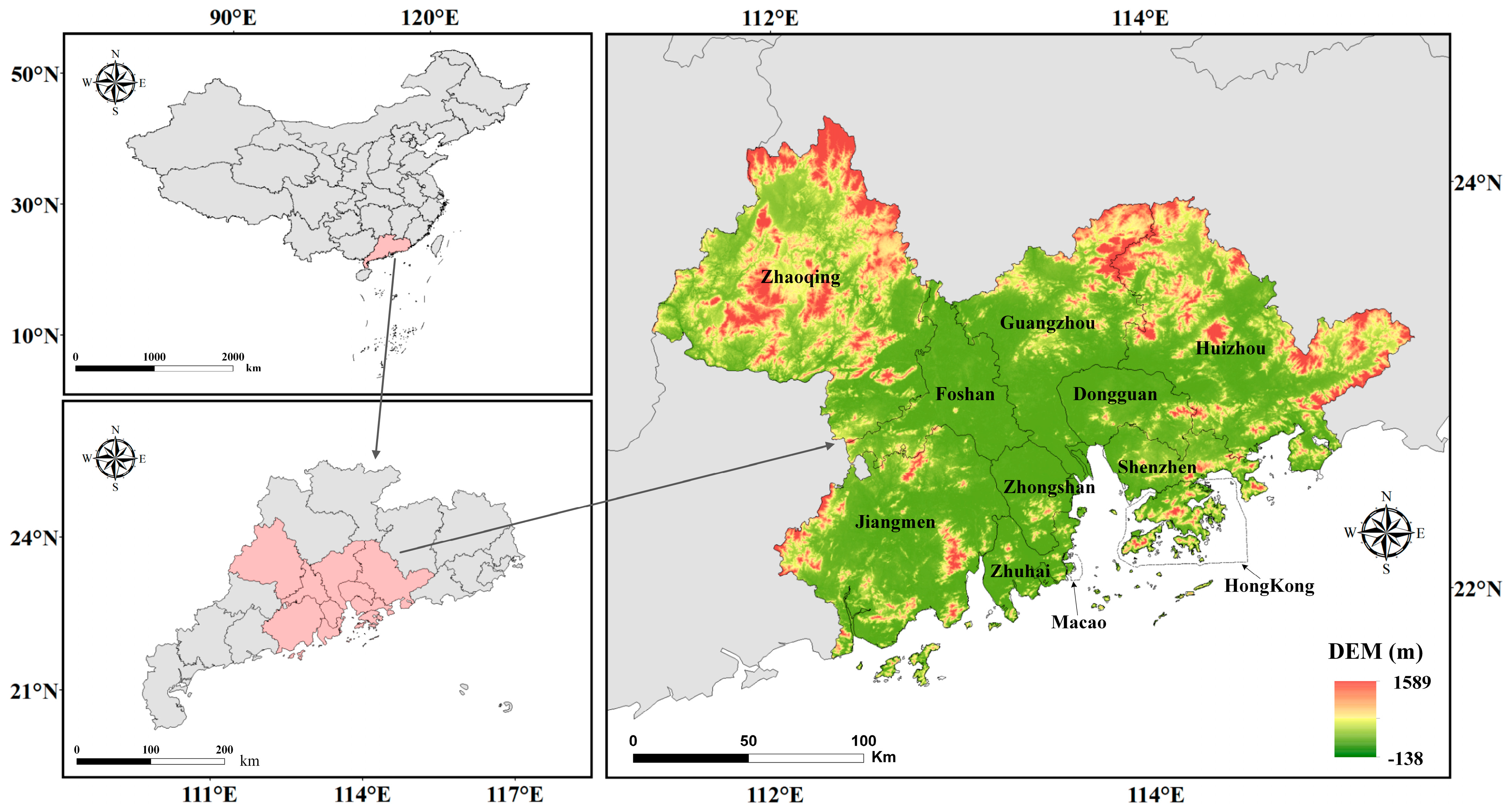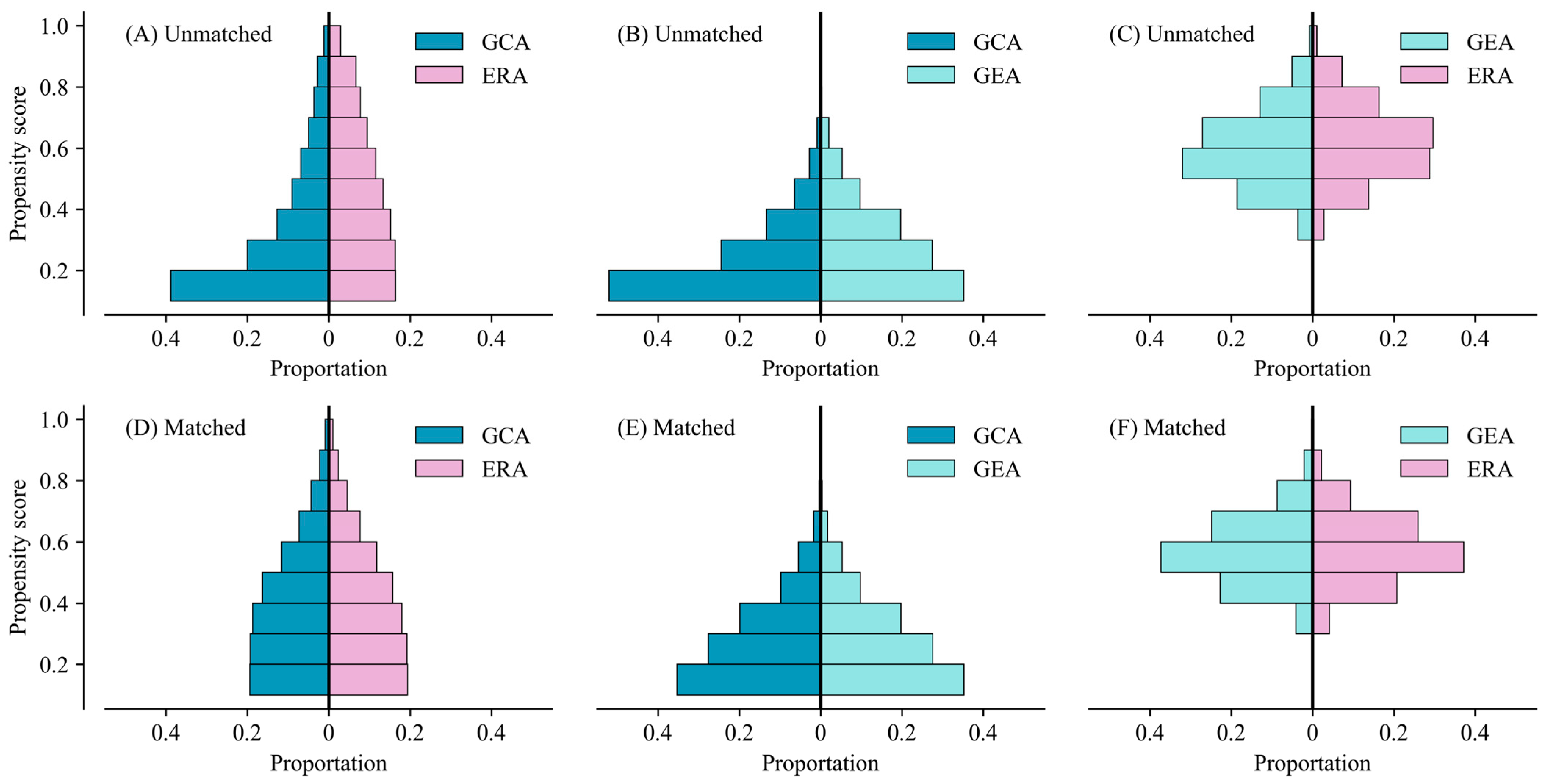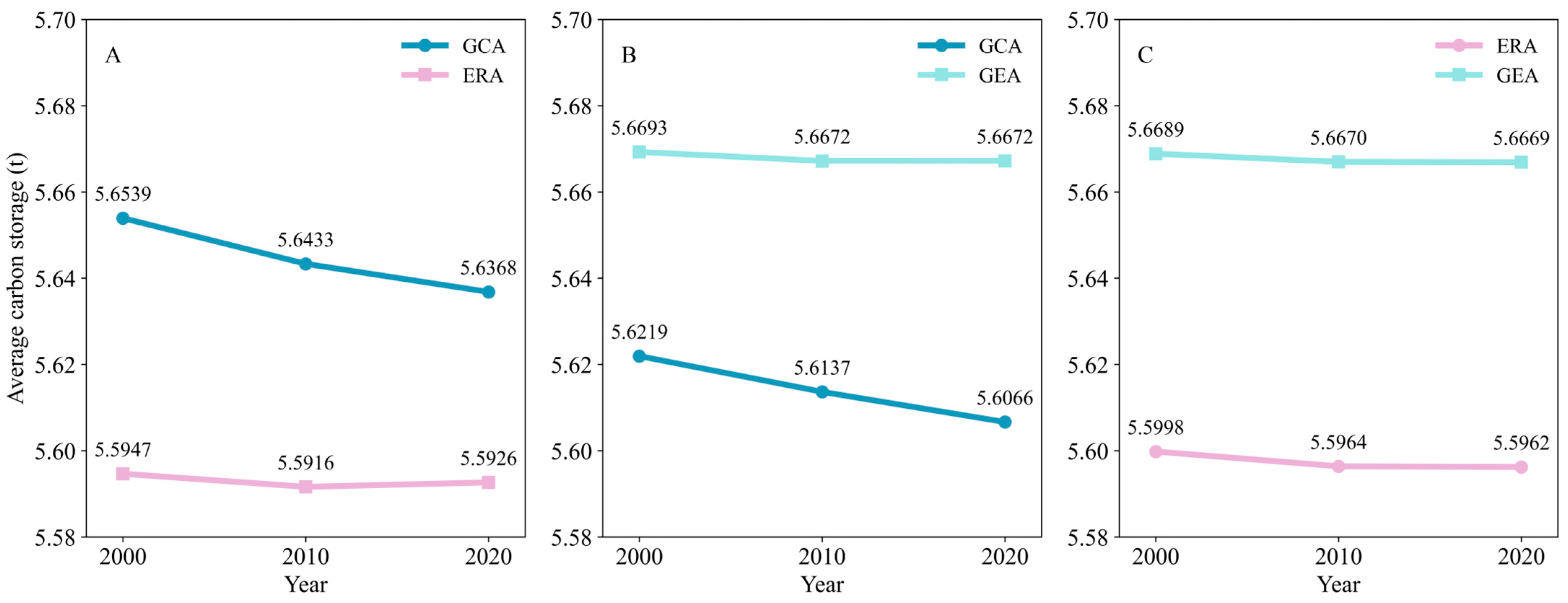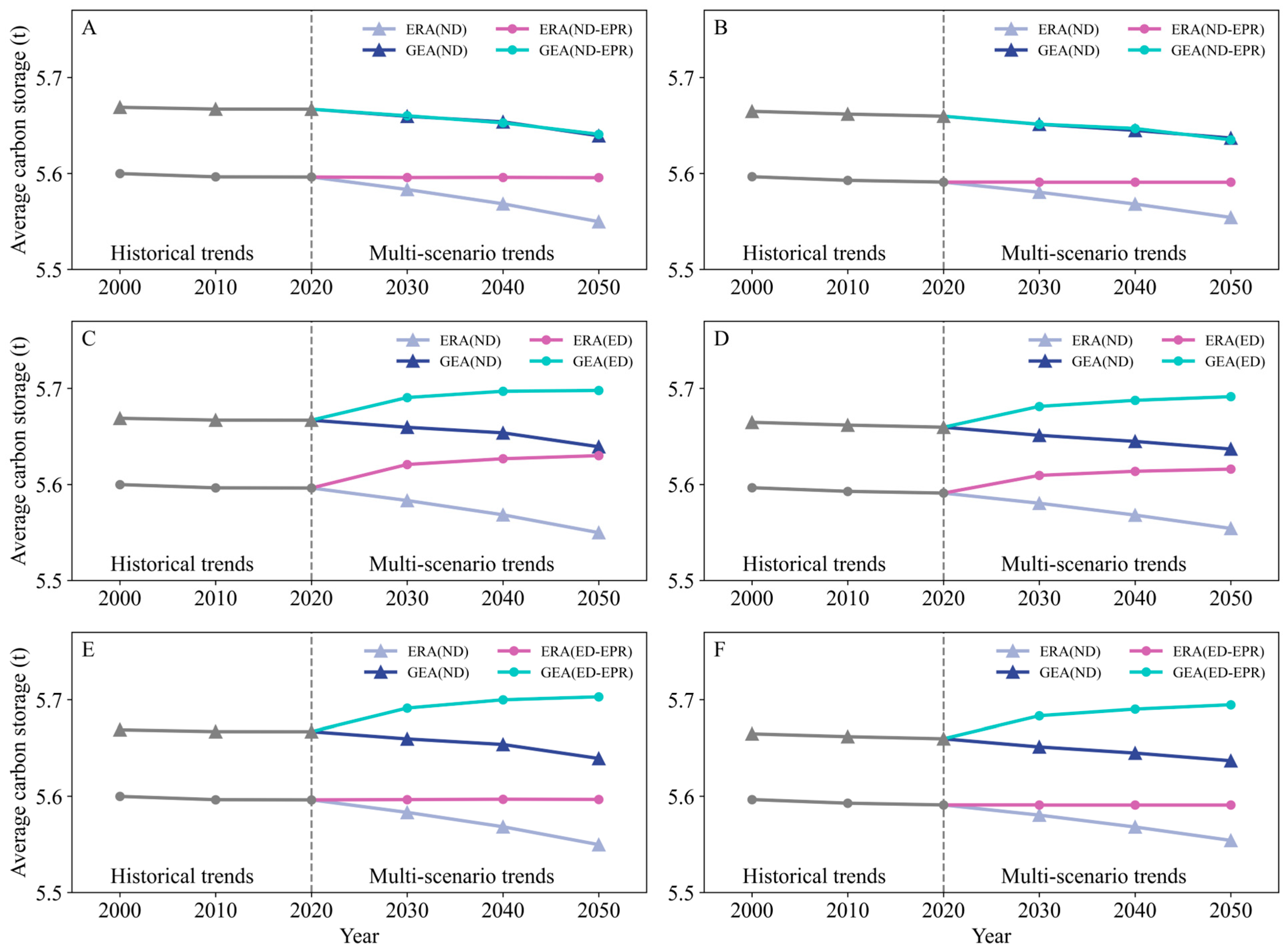Evaluation of Effectiveness and Multi-Scenario Analysis of Land Use Development Strategies and Ecological Protection Redlines on Carbon Storage in the Great Bay Area of China Using the PLUS-InVEST-PSM Model
Abstract
1. Introduction
2. Materials and Methods
2.1. Study Area
2.2. Data Source
2.3. Scenario-Based Carbon Storage Simulation
2.3.1. PLUS Model
2.3.2. InVEST Model
2.3.3. Land Use Simulation Scenarios
2.4. Effectiveness Evaluation with the PSM Mode
3. Results
3.1. Multi-Scenario Simulation of LULC
3.2. Dynamic of Carbon Storage Under Multiple Scenarios
3.3. Matching Results of the PSM Model
3.4. Effectiveness of Ecological Development Strategy and Ecological Protection Redline
4. Discussion
4.1. Comparison of the Impacts of Ecological Development Strategy and Ecological Protection Redline on Carbon Storage
4.2. The PSM Model vs. The Comparison Between the Subregions
4.3. Policy Implications
5. Conclusions
Author Contributions
Funding
Data Availability Statement
Conflicts of Interest
Appendix A
| Variables | Before PSM | After PSM | ||||
|---|---|---|---|---|---|---|
| General Ecological Area | Ecological Redline Area | p | General Ecological Area | Ecological Redline Area | p | |
| Population | 267.21 (−1030.11) | 222.66 (−863.64) | 0.004 ** | 267.99 (−1037.42) | 268.61 (−968.79) | 0.609 |
| GDP | 3,287,607.76 (−26,077,936.3) | 2,667,281.04 (−19,800,949.36) | 0.062 | 3,323,447.24 (−26,316,168.27) | 3,213,624.62 (−23,433,962.34) | 0.807 |
| Average annual precipitation | 1816.31 (−107) | 1828.48 (−98.8) | 0.001 *** | 1817.64 (−106.99) | 1821.42 (−97.67) | 0.039 * |
| Average annual temperature | 216.69 (−13.68) | 213.83 (−13.64) | 0.001 *** | 216.68 (−13.76) | 216.28 (−12.34) | 0.104 |
| DEM | 193.08 (−167.61) | 271.38 (−214.72) | 0.001 *** | 196.28 (−168.39) | 206.2 (−169.79) | 0.001 *** |
| Slope | 12.71 (−8.3) | 14.94 (−8.78) | 0.001 *** | 12.81 (−8.31) | 13.17 (−8.4) | 0.02 * |
| Aspect | 176.77 (−106.06) | 178.84 (−104.7) | 0.08 | 176.1 (−106.08) | 176.78 (−104.73) | 0.866 |
| Distance to railways | 24,349.78 (−17,182.82) | 24394.21 (−20320.69) | 0.89 | 24079.68 (−16974.07) | 23,666.81 (−20,220.8) | 0.136 |
| Distance to water | 2798.06 (−2346.63) | 3007.21 (−2612.04) | 0.001 *** | 2809.02 (−2339.12) | 2847.84 (−2611.16) | 0.386 |
| Distance to first-level roads | 6763.68 (−4397.06) | 6764.18 (−4327.96) | 0.886 | 6729.64 (−4386.74) | 6744.64 (−4447.68) | 0.866 |
| Distance to second-level roads | 6711.89 (−4946.78) | 6683.71 (−6409.06) | 0.001 *** | 6762.79 (−4968.94) | 6997.61 (−6203.41) | 0.012 * |
| Distance to third-level roads | 2496.02 (−1906.34) | 2663.37 (−2088.01) | 0.001 *** | 2604.76 (−1907.61) | 2600.6 (−2078.46) | 0.91 |
| Distance to highways | 8106.23 (−6968.61) | 8179.66 (−7438.61) | 0.641 | 8094.84 (−6932.27) | 8164.79 (−7646.42) | 0.604 |
| Soil types | 209.38 (−18.63) | 212.26 (−16.86) | 0.001 *** | 209.71 (−18.14) | 210.6 (−17.46) | 0.006 ** |
| Obs. | 6987 | 8797 | 6864 | 6864 | ||
References
- Chuai, X.; Huang, X.; Wang, W.; Zhao, R.; Zhang, M.; Wu, C. Land use, total carbon emissions change and low carbon land management in Coastal Jiangsu, China. J. Clean. Prod. 2015, 103, 77–86. [Google Scholar] [CrossRef]
- Sleeter, B.M.; Marvin, D.C.; Cameron, D.R.; Selmants, P.C.; Westerling, A.L.; Kreitler, J.; Daniel, C.J.; Liu, J.; Wilson, T.S. Effects of 21st-century climate, land use, and disturbances on ecosystem carbon balance in California. Glob. Chang. Biol. 2019, 25, 3334–3353. [Google Scholar] [CrossRef] [PubMed]
- Yang, Y.; Shi, Y.; Sun, W.; Chang, J.; Zhu, J.; Chen, L.; Wang, X.; Guo, Y.; Zhang, H.; Yu, L.; et al. Terrestrial carbon sinks in China and around the world and their contribution to carbon neutrality. Sci. China Life Sci. 2022, 65, 861–895. [Google Scholar] [CrossRef] [PubMed]
- Li, J.; Guo, X.; Chuai, X.; Xie, F.; Yang, F.; Gao, R.; Ji, X. Reexamine China’s terrestrial ecosystem carbon balance under land use-type and climate change. Land Use Policy 2021, 102, 105275. [Google Scholar] [CrossRef]
- Xu, Q.; Yang, R.; Dong, Y.-X.; Liu, Y.-X.; Qiu, L.-R. The influence of rapid urbanization and land use changes on terrestrial carbon sources/sinks in Guangzhou, China. Ecol. Indic. 2016, 70, 304–316. [Google Scholar] [CrossRef]
- Quesada, B.; Arneth, A.; Robertson, E.; de Noblet-Ducoudré, N. Potential strong contribution of future anthropogenic land-use and land-cover change to the terrestrial carbon cycle. Environ. Res. Lett. 2018, 13, 064023. [Google Scholar] [CrossRef]
- Zafar, Z.; Sajid Mehmood, M.; Shiyan, Z.; Zubair, M.; Sajjad, M.; Yaochen, Q. Fostering deep learning approaches to evaluate the impact of urbanization on vegetation and future prospects. Ecol. Indic. 2023, 146, 109788. [Google Scholar] [CrossRef]
- Piao, S.; Wang, X. Biological systems under climate change: What do we learn from the IPCC AR6. Glob. Chang. Biol. 2023, 29, 5120–5121. [Google Scholar] [CrossRef]
- Chen, G.; Li, X.; Liu, X.; Chen, Y.; Liang, X.; Leng, J.; Xu, X.; Liao, W.; Qiu, Y.; Wu, Q.; et al. Global projections of future urban land expansion under shared socioeconomic pathways. Nat. Commun. 2020, 11, 537. [Google Scholar] [CrossRef]
- Mendoza-Ponce, A.; Corona-Núñez, R.O.; Kraxner, F.; Leduc, S.; Patrizio, P. Identifying effects of land use cover changes and climate change on terrestrial ecosystems and carbon stocks in Mexico. Glob. Environ. Chang. 2018, 53, 12–23. [Google Scholar] [CrossRef]
- Zhu, W.; Zhang, J.; Cui, Y.; Zhu, L. Ecosystem carbon storage under different scenarios of land use change in Qihe catchment, China. J. Geogr. Sci. 2020, 30, 1507–1522. [Google Scholar] [CrossRef]
- Gizachew, B.; Solberg, S.; Puliti, S. Forest Carbon Gain and Loss in Protected Areas of Uganda: Implications to Carbon Benefits of Conservation. Land 2018, 7, 138. [Google Scholar] [CrossRef]
- Liu, X.; Xia, L.; Xun, L.; Hong, S.; Ou, J.P. Simulating the Change of Terrestrial Carbon Storage in China Based on the FLUS-InVEST Model. Trop. Geogr. 2019, 39, 397–409. (In Chinese) [Google Scholar]
- Yang, L.; Zhao, J.; Zhu, J.; Liu, L.; Zhang, P. Spatial—Temporal change and prediction of carbon stock in the ecosystem of Xi’an based on PLUS and InVEST models. Remote Sens. Nat. Resour. 2022, 34, 175–182. [Google Scholar] [CrossRef]
- Gong, W.; Duan, X.; Sun, Y.; Zhang, Y.; Ji, P.; Tong, X.; Qiu, Z.; Liu, T. Multi-scenario simulation of land use/cover change and carbon storage assessment in Hainan coastal zone from perspective of free trade port construction. J. Clean. Prod. 2023, 385, 135630. [Google Scholar] [CrossRef]
- Zou, N.; Wang, C.; Wang, S.; Li, Y. Impact of ecological conservation policies on land use and carbon stock in megacities at different stages of development. Heliyon 2023, 9, e18814. [Google Scholar] [CrossRef]
- Yang, S.; Li, L.; Zhu, R.; Luo, C.; Lu, X.; Sun, M.; Xu, B. Assessing land-use changes and carbon storage: A case study of the Jialing River Basin, China. Sci. Rep. 2024, 14, 1–18. [Google Scholar] [CrossRef]
- Jia, P. Ecological Protection Redlines’ Positive Impact on Terrestrial Carbon Storage in Hainan Island, China. Land 2024, 13, 1292. [Google Scholar] [CrossRef]
- Hwang, J.; Choi, Y.; Kim, Y.; No Ol, L.; Yoo, Y.-J.; Cho, H.J.; Sun, Z.; Jeon, S. Analysis of the effect of environmental protected areas on land-use and carbon storage in a megalopolis. Ecol. Indic. 2021, 133, 108352. [Google Scholar] [CrossRef]
- Ferraro, P.J.; Pattanayak, S.K. Money for Nothing? A Call for Empirical Evaluation of Biodiversity Conservation Investments. PLOS Biol. 2006, 4, e105. [Google Scholar] [CrossRef]
- Ribas, L.G.D.S.; Pressey, R.L.; Loyola, R.; Bini, L.M. A global comparative analysis of impact evaluation methods in estimating the effectiveness of protected areas. Biol. Conserv. 2020, 246, 108595. [Google Scholar] [CrossRef]
- Chen, H.; Dong, N.; Liang, X.; Huang, H. Spatiotemporal Evaluation of Regional Land Use Dynamics and Its Potential Ecosystem Impact under Carbon Neutral Pathways in the Guangdong–Hong Kong–Macao Greater Bay Area. Remote Sens. 2023, 15, 5749. [Google Scholar] [CrossRef]
- Gu, Y.; Lin, N.; Ye, X.; Xu, M.; Qiu, J.; Zhang, K.; Zou, C.; Qiao, X.; Xu, D. Assessing the impacts of human disturbance on ecosystem services under multiple scenarios in karst areas of China: Insight from ecological conservation red lines effectiveness. Ecol. Indic. 2022, 142, 109202. [Google Scholar] [CrossRef]
- Guo, H.; Du, E.; Terrer, C.; Jackson, R.B. Global distribution of surface soil organic carbon in urban greenspaces. Nat. Commun. 2024, 15, 806. [Google Scholar] [CrossRef] [PubMed]
- Pfaff, A.; Robalino, J.; Sandoval, C.; Herrera, D. Protected area types, strategies and impacts in Brazil’s Amazon: Public protected area strategies do not yield a consistent ranking of protected area types by impact. Philos. Trans. R. Soc. B Biol. Sci. 2015, 370, 20140273. [Google Scholar] [CrossRef]
- Brooks, T.M.; Mittermeier, R.A.; Da Fonseca, G.A.; Gerlach, J.; Hoffmann, M.; Lamoreux, J.F.; Mittermeier, C.G.; Pilgrim, J.D.; Rodrigues, A.S. Global biodiversity conservation priorities. Science 2006, 313, 58–61. [Google Scholar] [CrossRef]
- Hoekstra, J.M.; Boucher, T.M.; Ricketts, T.H.; Roberts, C. Confronting a biome crisis: Global disparities of habitat loss and protection. Ecol. Lett. 2005, 8, 23–29. [Google Scholar] [CrossRef]
- Vieira, R.R.; Pressey, R.L.; Loyola, R. The residual nature of protected areas in Brazil. Biol. Conserv. 2019, 233, 152–161. [Google Scholar] [CrossRef]
- Granger, E.; Watkins, T.; Sergeant, J.C.; Lunt, M. A review of the use of propensity score diagnostics in papers published in high-ranking medical journals. BMC Med. Res. Methodol. 2020, 20, 1–9. [Google Scholar] [CrossRef]
- Thoemmes, F.J.; Kim, E.S. A Systematic Review of Propensity Score Methods in the Social Sciences. Multivar. Behav. Res. 2011, 46, 90–118. [Google Scholar] [CrossRef]
- Zhang, Y.; Li, J.; Tao, W. Does energy efficiency affect appliance prices? Empirical analysis of air conditioners in China based on propensity score matching—ScienceDirect. Energy Econ. 2021, 101, 105435. [Google Scholar] [CrossRef]
- Zhang, H.; Li, X.; Liu, X.; Chen, Y.; Ou, J.; Niu, N.; Jin, Y.; Shi, H. Will the Development of a High-Speed Railway Have Impacts on Land Use Patterns in China? Ann. Am. Assoc. Geogr. 2019, 109, 1005–1979. [Google Scholar] [CrossRef]
- Shi, H.; Li, X.; Liu, X.; Wang, S.; Liu, X.; Zhang, H.; Tang, D.; Li, T. Global protected areas boost the carbon sequestration capacity: Evidences from econometric causal analysis. Sci. Total Environ. 2020, 715, 137001. [Google Scholar] [CrossRef]
- Bai, Y.; Jiang, B.; Wang, M.; Li, H.; Alatalo, J.M.; Huang, S. New ecological redline policy (ERP) to secure ecosystem services in China. Land Use Policy 2016, 55, 348–351. [Google Scholar] [CrossRef]
- Gao, J.; Zou, C.; Zhang, K.; Xu, M.; Wang, Y. The establishment of Chinese ecological conservation redline and insights into improving international protected areas. J. Environ. Manag. 2020, 264, 110505. [Google Scholar] [CrossRef]
- Sang, W.; Axmacher, J. Environment: China draws lines to green future. Nature 2016, 531, 305. [Google Scholar] [CrossRef]
- Xu, X.; Liu, J.; Zhang, S.; Li, R.; Yan, C.; Wu, S.J.R. China’s Multi-Period Land Use Land Cover Remote Sensing Monitoring Data Set (CNLUCC); Environment Data Cloud Platform: Beijing, China, 2018. [Google Scholar]
- Peel, M.C.; Finlayson, B.L.; McMahon, T.A. Updated world map of the Köppen-Geiger climate classification. Hydrol. Earth Syst. Sci. 2007, 11, 1633–1644. [Google Scholar] [CrossRef]
- Wu, B.; Lang, X.; Jiang, D. Köppen Climate Zones in China Over the Last 21,000 Years. J. Geophys. Res. Atmos. 2021, 126, e2020JD034310. [Google Scholar] [CrossRef]
- Liang, X.; Guan, Q.; Clarke, K.C.; Liu, S.; Wang, B.; Yao, Y. Understanding the drivers of sustainable land expansion using a patch-generating land use simulation (PLUS) model: A case study in Wuhan, China. Comput. Environ. Urban Syst. 2021, 85, 101569. [Google Scholar] [CrossRef]
- Clarke, K.C.; Hoppen, S.; Gaydos, L. A Self-Modifying Cellular Automaton Model of Historical Urbanization in the San Francisco Bay Area. Environ. Plan. B Plan. Des. 1997, 24, 247–261. [Google Scholar] [CrossRef]
- Liu, X.; Liang, X.; Li, X.; Xu, X.; Ou, J.; Chen, Y.; Li, S.; Wang, S.; Pei, F. A future land use simulation model (FLUS) for simulating multiple land use scenarios by coupling human and natural effects. Landsc. Urban Plan. 2017, 168, 94–116. [Google Scholar] [CrossRef]
- Piyathilake, I.D.U.H.; Udayakumara, E.P.N.; Ranaweera, L.V.; Gunatilake, S.K. Modeling predictive assessment of carbon storage using InVEST model in Uva province, Sri Lanka. Model. Earth Syst. Environ. 2021, 8, 2213–2223. [Google Scholar] [CrossRef]
- Rosenbaum, P.R.; Rubin, D.B. The central role of the propensity score in observational studies for causal effects. Biometrika 1983, 70, 41–55. [Google Scholar] [CrossRef]
- Abadie, A.; Imbens, G.W. Matching on the Estimated Propensity Score. Econometrica 2016, 84, 781–807. [Google Scholar] [CrossRef]
- Cazalis, V.; Prince, K.; Mihoub, J.B.; Kelly, J.; Butchart, S.H.M.; Rodrigues, A.S.L. Effectiveness of protected areas in conserving tropical forest birds. Nat. Commun. 2020, 11, 4461. [Google Scholar] [CrossRef]
- Bertrand, M.; Duflo, E.; Mullainathan, S. How Much Should We Trust Differences-In-Differences Estimates? Q. J. Econ. 2004, 119, 249–275. [Google Scholar] [CrossRef]
- Shao, S.; Tian, Z.; Yang, L. High speed rail and urban service industry agglomeration: Evidence from China’s Yangtze River Delta region. J. Transp. Geogr. 2017, 64, 174–183. [Google Scholar] [CrossRef]
- McDonald, R.I.; Boucher, T.M. Global development and the future of the protected area strategy. Biol. Conserv. 2011, 144, 383–392. [Google Scholar] [CrossRef]
- Campbell, A.; Dickson, B.; Gibbs, H.; Hansen, M.; Kapos, V.; Lysenko, I.; Miles, L.; Scharlemann, J. The role of protected areas in storing carbon and reducing emissions. IOP Conf. Ser. Earth Environ. Sci. 2009, 6, 252025. [Google Scholar] [CrossRef]
- Melillo, J.M.; Lu, X.; Kicklighter, D.W.; Reilly, J.M.; Cai, Y.; Sokolov, A.P. Protected areas’ role in climate-change mitigation. Ambio 2016, 45, 133–145. [Google Scholar] [CrossRef]
- Gundersen, P.; Thybring, E.E.; Nord-Larsen, T.; Vesterdal, L.; Nadelhoffer, K.J.; Johannsen, V.K. Old-growth forest carbon sinks overestimated. Nature 2021, 591, E21–E23. [Google Scholar] [CrossRef]
- Kim, M.; Kraxner, F.; Forsell, N.; Song, C.; Lee, W.-K. Enhancing the provisioning of ecosystem services in South Korea under climate change: The benefits and pitfalls of current forest management strategies. Reg. Environ. Change 2021, 21, 1–10. [Google Scholar] [CrossRef]
- Bruner, A.G.; Gullison, R.E.; Balmford, A. Financial Costs and Shortfalls of Managing and Expanding Protected-Area Systems in Developing Countries. BioScience 2004, 54, 1119–1126. [Google Scholar] [CrossRef]
- Yang, H.; Vina, A.; Winkler, J.A.; Chung, M.G.; Huang, Q.; Dou, Y.; McShea, W.J.; Songer, M.; Zhang, J.; Liu, J. A global assessment of the impact of individual protected areas on preventing forest loss. Sci. Total Environ. 2021, 777, 145995. [Google Scholar] [CrossRef]
- Guo, X.; Zhang, Y.; Guo, D.; Lu, W.; Xu, H.F. How does ecological protection redline policy affect regional land use and ecosystem services? Environ. Impact Assess. Rev. 2023, 100, 107062. [Google Scholar] [CrossRef]
- Hua, H.; Zhang, X.; Zhou, Y.; Sun, J.; Chen, X. Multi-scenario prediction and attribution analysis of carbon storage of ecological system in the Huaihe River Basin, China. Environ. Monit. Assess. 2024, 196, 1–23. [Google Scholar] [CrossRef]
- Wu, Q.; Wang, L.; Wang, T.; Ruan, Z.; Du, P. Spatial–temporal evolution analysis of multi-scenario land use and carbon storage based on PLUS-InVEST model: A case study in Dalian, China. Ecol. Indic. 2024, 166, 112448. [Google Scholar] [CrossRef]
- Dewulf, J.; Benini, L.; Mancini, L.; Sala, S.; Blengini, G.A.; Ardente, F.; Recchioni, M.; Maes, J.; Pant, R.; Pennington, D. Rethinking the area of protection “natural resources” in life cycle assessment. Environ. Sci. Technol. 2015, 49, 5310–5317. [Google Scholar] [CrossRef]
- Kearney, S.G.; Adams, V.M.; Fuller, R.A.; Possingham, H.P.; Watson, J.E.M. Estimating the benefit of well-managed protected areas for threatened species conservation. Oryx 2018, 54, 276–284. [Google Scholar] [CrossRef]
- Wang, N.; Du, Y.; Liang, F.; Yi, J.; Qian, J.; Tu, W.; Huang, S.; Luo, P. Protected areas effectively resisted 33.8% of urban development pressures in China during 2000–2018. Appl. Geogr. 2023, 159, 103079. [Google Scholar] [CrossRef]
- Yu, C.; Zhang, Z.; Jeppesen, E.; Gao, Y.; Liu, Y.; Liu, Y.; Lu, Q.; Wang, C.; Sun, X. Assessment of the effectiveness of China’s protected areas in enhancing ecosystem services. Ecosyst. Serv. 2024, 65, 101588. [Google Scholar] [CrossRef]
- Wang, X.; Wen, Y.; Liu, X.; Wen, D.; Long, Y.; Zhao, P.; Liu, P.; Zhong, J. Protection Effect and Vacancy of the Ecological Protection Redline: A Case Study in Guangdong–Hong Kong–Macao Greater Bay Area, China. Remote Sens. 2021, 13, 5171. [Google Scholar] [CrossRef]









| Variables | Data Source | Resolution | Year |
|---|---|---|---|
| Natural data | |||
| Average annual temperature | Resources and Environment Science Data Platform (http://www.resdc.cn, accessed on 1 April 2024) | 1000 m | 2020 |
| Average annual precipitation | 2020 | ||
| Soil types | 1995 | ||
| DEM | Geospatial Data Cloud (https://www.gscloud.cn/, accessed on 1 April 2024) | 30 m | |
| Slope | |||
| Aspect | |||
| Social-economic data | |||
| Population | Resources and Environment Science Data Platform (http://www.resdc.cn, accessed on 1 April 2024) | 1000 m | 2020 |
| Gross Domestic Product | 2020 | ||
| Distance to railways | National Geomatics Center of China (https://www.ngcc.cn/, accessed on 1 April 2024) | 30 m | 2024 |
| Distance to motorways | 2024 | ||
| Distance to buildings | 2024 | ||
| Distance to first-level roads | 2024 | ||
| Distance to second-level roads | 2024 | ||
| Distance to third-level roads | 2024 | ||
| Distance to water | 2024 | ||
Disclaimer/Publisher’s Note: The statements, opinions and data contained in all publications are solely those of the individual author(s) and contributor(s) and not of MDPI and/or the editor(s). MDPI and/or the editor(s) disclaim responsibility for any injury to people or property resulting from any ideas, methods, instructions or products referred to in the content. |
© 2024 by the authors. Licensee MDPI, Basel, Switzerland. This article is an open access article distributed under the terms and conditions of the Creative Commons Attribution (CC BY) license (https://creativecommons.org/licenses/by/4.0/).
Share and Cite
Jin, Y.; Li, Y.; Zhang, H.; Liu, X.; Shi, H. Evaluation of Effectiveness and Multi-Scenario Analysis of Land Use Development Strategies and Ecological Protection Redlines on Carbon Storage in the Great Bay Area of China Using the PLUS-InVEST-PSM Model. Land 2024, 13, 1918. https://doi.org/10.3390/land13111918
Jin Y, Li Y, Zhang H, Liu X, Shi H. Evaluation of Effectiveness and Multi-Scenario Analysis of Land Use Development Strategies and Ecological Protection Redlines on Carbon Storage in the Great Bay Area of China Using the PLUS-InVEST-PSM Model. Land. 2024; 13(11):1918. https://doi.org/10.3390/land13111918
Chicago/Turabian StyleJin, Yuhao, Yan Li, Han Zhang, Xiaojuan Liu, and Hong Shi. 2024. "Evaluation of Effectiveness and Multi-Scenario Analysis of Land Use Development Strategies and Ecological Protection Redlines on Carbon Storage in the Great Bay Area of China Using the PLUS-InVEST-PSM Model" Land 13, no. 11: 1918. https://doi.org/10.3390/land13111918
APA StyleJin, Y., Li, Y., Zhang, H., Liu, X., & Shi, H. (2024). Evaluation of Effectiveness and Multi-Scenario Analysis of Land Use Development Strategies and Ecological Protection Redlines on Carbon Storage in the Great Bay Area of China Using the PLUS-InVEST-PSM Model. Land, 13(11), 1918. https://doi.org/10.3390/land13111918






